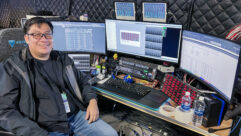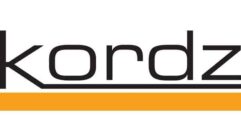
Installation Profile: Rockford Files
Mar 1, 2004 12:00 PM,
By Chris Hamilton
Exterior of Rockford High.
A common scenario today is the need for a K-12 school district with multiple buildings geographically separated, each housing traditional analog educational media (VHS, DVD, Laserdisc, and so on) to infuse exciting video into the standard curriculum. To meet this need, technology integrators and consultants are implementing traditional analog delivery solutions for schools. Although this solution is effective for the requirements of many districts, particularly where there are connectivity “bottlenecks” between buildings, it may not be the answer for all districts. Today more and more school districts are overcoming connectivity hurdles by becoming fiber interconnected. This connectivity, coupled with technological advances in Quality of Service (QoS), has enabled the convergence of efficient, reliable video distribution over the LAN/MAN and has become a viable alternative to traditional analog methods.
LEAVING NO CHILD BEHIND
Rockford Public Schools, a Blue Ribbon Award — winning district of approximately 7,600 students and 12 school buildings, is located in western Michigan. Typical of most school districts, funding has been cut to an all-time low while pressure to use technology to enhance traditional curriculum for “No Child Left Behind” mandates has increased.
Optibase MGW 2000

At Rockford technology initiatives were formed to converge disparate technologies to their newly implemented, high-bandwidth metropolitan area network (MAN). Convergence of voice, using 3Com NBX IP Telephony, traditional data traffic, and a state-of-the-art video streaming and control system, allows maximum use of the data network infrastructure. For video applications, in particular, a network-delivery model provides a phenomenal medium for the delivery of content-rich media for teachers and students.
The network needed to provide easily managed bandwidth, and lots of it. From the start, Rockford’s Operational Technology Department recognized that design requirements called for a robust network, and that’s what it pursued. The department selected Extreme Networks as the manufacturer of the core of the data network, choosing Extreme’s Black Diamond 6800 — series data switch for its performance in high-bandwidth applications. With support included for DiffServ, IEEE 802.1p, VLAN switching capabilities, and easy software-based management using ExtremeWare, the Black Diamond was a logical choice to build around.
Two Black Diamonds, one at Rockford High School and the other at East Middle School, which are interconnected by single-mode fiber, provide the network core. The remaining schools, which use 3Com data switches, are connected to each core switch through a single-mode fiber, offering a redundant 1 GB data backbone for the district. Each classroom, in turn, is switched a full 100 Mbps through Cat-5e cable. With a robust network in place, the timing was perfect for the implementation of the district video system.
A DESIGN/BUILD PARTNERSHIP
The Rockford operational technical staff looked to Safari Technologies, an educational video solution provider based in Michigan, to assist them in the design, implementation, training, and ongoing development of the streaming-video system. The approach was simple yet effective: design and implement a system that achieved several fundamental design requirements. First, it must provide for extremely low video latency, which is important when interactively controlling a real-time analog video source, which may reside miles away. Second, the system must provide for easy-to-use video resource scheduling and reporting through a standard PC Internet browser. Third, the system must use a single client software interface for both the streaming video and source device control. Fourth and finally, the system must also allow for the delivery of stored digital video-on-demand content from a centrally located video content server.
Equipment rack housing servers

“We wanted video-based education to be an integrated part of our curriculum, available on-demand, at any of the schools in our district, at any time. We also did not want to incur huge costs, and we wanted to offer ease of use to our staff,” says Jill Nabozny, director of operational technology for the district. “In order to enhance each school’s teaching resources, we looked for a way to leverage our existing video education assets by sharing traditional content and also by adding additional stored digital video content. The solution that Safari customized for our district includes remote LAN-based control of the analog video sources. This architecture enables each of our schools to access, control, and view media located in any of the other district schools. That was our primary goal.”
VIDEO STREAMING IN A SNAP
Because low latency of video streams was required to make interactive control of source equipment effective, Safari chose to integrate the Optibase MGW 2000 MPEG 1&2 encoding and streaming server for the project.
“Optibase’s MGW 2000 provided the answer to our requirements of high quality, extremely low-latency streaming, while providing proven 24/7 reliability,” says Dave Rittenhouse, Safari video engineer. “MGW 2000 also provides us with a Web-manageable, 2 RU 19-inch rack chassis that allows up to six encoding modules in one piece of hardware. For video head-end applications, it’s ideal.” Each MGW 2000 allows for six analog video sources to be streamed in a variety of MPEG formats, as multicast or unicast streams on the district’s network. The MGW 2000 is fully Web managed, allowing district tech personnel to monitor and manage all streams, districtwide, from their remote office desk. “I like the fact that the MGW 2000 is DiffServ and QoS compliant. Being able to properly manage our network using flexible configurations in both the Extreme and Optibase gear really makes our jobs much easier,” says Peter Young, network operations coordinator for Rockford schools. The connectivity of the MGW 2000 encoding modules includes BNC composite video and S-video input and stereo audio input. Video parameters such as brightness, contrast, and hue can all be adjusted as necessary using the Optibase Web-based management interface. Also, depending on the encoding module selected for use in the MGW 2000, SDI input can be used along with streaming support up to MPEG-2 full D-1 encoding at 15 Mbps. A new Traffic Shaping feature optimizes video playback quality, particularly at lower bit rates.
SOURCE CONTROL AND SCHEDULING
Safari Technologies Device Commander

System designers at Safari used Pathway TCP/IP control products for the wide area system source control and scheduling of the district-owned VCRs and DVD players that were already deployed in the schools. On the hardware side, Safari ASC3000 infrared device controllers provide the IR commands to Mitsubishi HSU-series VCRs and Pioneer DVD-7400 industrial-grade DVD players. The controllers, which are IR programmable to nonvolatile RAM, receive IP commands from a Safari Pathway administration server, which resides in Rockford’s primary data center located in the high school. This Dell PowerEdge server, which runs Windows 2000 server OS, provides total database management of all aspects of the video system and also acts as the Web server for Safari’s Web-based Scheduling and Admin Reports functions. The media scheduler lets teachers reserve video media titles from their classroom PC while the Admin Reports allow district administration to monitor usage of the system and its resources. “Reliable source control is a great aspect of our system,” says Young. “The controllers can be programmed easily, and the IP-based control has been very reliable. Even if I’m in a school at one side of the district and I am controlling a VCR on the other side of the district, miles away, the control is instantaneous.”TRADITIONAL ANALOG MEDIAFor teacher access to the video system, the Rockford op tech team designed a PC Web interface named RPS Video Services. The purpose was to give teachers a single icon on the PC desktop to access any type of video, whether it is live streaming video from an analog source or video-on-demand (VoD) content. “We wanted to make sure that the video system would not distract teachers from their main focus. It had to be easy to use,” says Nabozny. When RPS Video Services is opened, screen icons give teachers access to Live Feeds (analog sources) or Encoded Video (VoD content). Upon selecting Live Feeds, Safari’s Device Commander interface opens and allows point-and-click access to any VCR or DVD player districtwide. The available system devices are displayed in a simple menu that is customizable by teacher login, if desired. In addition, source control buttons change dynamically depending on the source type that a teacher selects.“Simplicity was our driving criteria,” says David Gappa, software development manager for Safari. “We know that the easier technology is, the more it will be used,” says Nabozny.Once a source device is selected, the MPEG multicast stream is displayed in an embedded Windows MediaPlayer window within the Device Commander. “We chose to embed MediaPlayer instead of using a separate window so that the only control buttons a teacher could access would control the video source and not the video stream. Dual controls would confuse the user,” says Gappa.VIDEO ON DEMANDVoD is handled by a Safari eDireq digital content server housed in the primary data center of Rockford High School. This 160 GB network attached storage server houses educational videos that RPS acquires digital rights to through its cooperative with a regional education media center. It also includes student/staff-produced videos that are encoded into MPEG format. Media specialists now encode student news programming for on-demand use. The superintendent of schools, Dr. Michael Shibler, has encoded a district Code Red safety video into MPEG format for use on the VoD digital content server. Teachers have the ability to search available titles and play back or download the video to their classroom PC. Teacher-designated sections of videos can be created, allowing teachers to “capture the teachable moment” with engaging sections of video that create emphasis in their lesson plan. Videos are added to the system using a drag-and-drop technique. There are no confusing FTP uploads used in this system. The user simply encodes an MPEG file, drags the movie file onto a desktop icon, and gives the video a logical name. Once named the file automatically transfers over the network to the server and is available for use.VIDEO DISPLAY IN THE CLASSROOMSerious thought was put into classroom display devices because of the important role that video would play in Rockford’s technology infusion. Effective video learning depends on each student being able to see and hear all of the information presented in the classroom. For this reason, 34-inch NetTV data monitors were specified for each classroom. Because of the native 1024-by-768 resolution of these monitors and their built-in 12W stereo audio, students can easily see and hear throughout the room. The NetTV monitors feature dual HD-15 pin computer input, one rear and one front, single HD-15 output, dual composite video inputs, and a single S-video input.Each of the eight Rockford elementary schools houses two Mitsubishi HSU VCRs and one Pioneer DVD-V7400 DVD player. Three Safari ASC3000 infrared source controllers provide the hardware interface for LAN-based control of the sources. The two Rockford middle schools each house four VCRs and two DVD players. Finally, the 9th Grade Freshman Center, which is in a campus layout with the high school, is home to 18 VCRs and 5 DVD players. All video sources feed the MGW 2000 MPEG encoding modules through S-video connections for signal quality as well as stereo audio.Rockford High School, which is home base for the op tech staff, houses the Safari Admin Server and the VoD content server. All educational CATV programming is streamed from the high school location. In all 70 analog video channels are streaming across the district MAN on a 24/7 basis.A PROJECT PARTNERSHIPFrom the outset, RPS and Safari staffs structured the project relationship as a partnership. District staff was involved in all aspects of implementation. A district technician directly installed and configured equipment along with Safari Technologies integration personnel. This leads to a high technical level of competency at the district level right from the start. Small technical issues can be handled directly by the district instead of an expensive service call to the integrator. Initially, there are short-term out-of-pocket expenses for the integrator, but in the long-term, this fosters a bonding relationship between the customer and integrator, leading to long-lasting mutual benefits and rewards.On-site training was provided by a Safari trainer and is ongoing by dedicated district trainers to continually drive staff development. As with any technology system, if users are not properly trained, the system will not be effectively used.THE BOTTOM LINEROI in this case is not only the return on investment in dollars (money saved in infrastructure, analog distribution hardware, and so on) but also ROI in educational benefit value for teachers and, most importantly, for students. Educators today must stretch more educational benefit out of every precious dollar.Standard and Poor’s (S&P), which offers nationally recognized investment indexing, also offers assessment services for schools. The most recent S&P Performance Cost Index for Rockford was in the top 2 percent of all Michigan schools. This performance is not directly attributable solely to the video system. But the culmination of many district initiatives, including technology infusion into the curriculum, would appear to be contributing factors.So what are the advantages? Where does the district save money?First, all video resources are centrally managed and use a single data network delivery method. Second, fewer analog sources are needed districtwide. At Rockford a total of 42 VCRs and 17 DVD players service the entire district of 650-plus classrooms. Third, cabling infrastructure in their new construction was substantially reduced. No video dedicated coax, fiber, or UTP was needed. Only the infrastructure that had to be used for data was installed.Also, numbers alone cannot measure the advantages. “Imagine a classroom that offers students the chance to visually explore the world of an amoeba, to drop in on William Shakespeare, to roam with the dinosaurs,” says Nabozny. “A classroom that takes them to the Battle of Gettysburg, leaves textbooks behind. In one afternoon, students can learn to speak a foreign language and walk on the moon. Motivation will obviously soar in such a classroom. Now imagine a technology system that creates these experiences using high-quality video images delivered to any classroom, anywhere in the district. You don’t have to wander too far — the technology already exists. Educators face challenges every day, and we wanted to make sure that our video services system would not distract teachers from their main focus. Thanks to the simplicity of the Safari system, video delivery in our school district has become an enabling tool that enriches both the learning and teaching experiences of our students and staff.”This may not be the system for every district, but solutions such as this should be seriously considered if the bandwidth and content are in place. Competent personnel, both in the district and with the integrator, will ensure that the project is properly designed, implemented, and managed.Chris Hamiltonis director of educational sales for Midwest Concepts Corp. He can be reached at[email protected].Web ExclusiveFor more about applying technology to enhance the school experience, see the Web exclusive “Wi-Fi High” onwww.svconline.com.For More InformationDell
www.dell.comExtreme Networks
www.extremenetworks.comMicrosoft
www.microsoft.comMitsubishi
www.mitsubishi.comNetTV
www.net-tv.netOptibase
www.optibase.comPioneer Electronics
www.pioneerelectronics.comSafari Technologies
www.safaripathways.com3Com
www.3com.com










